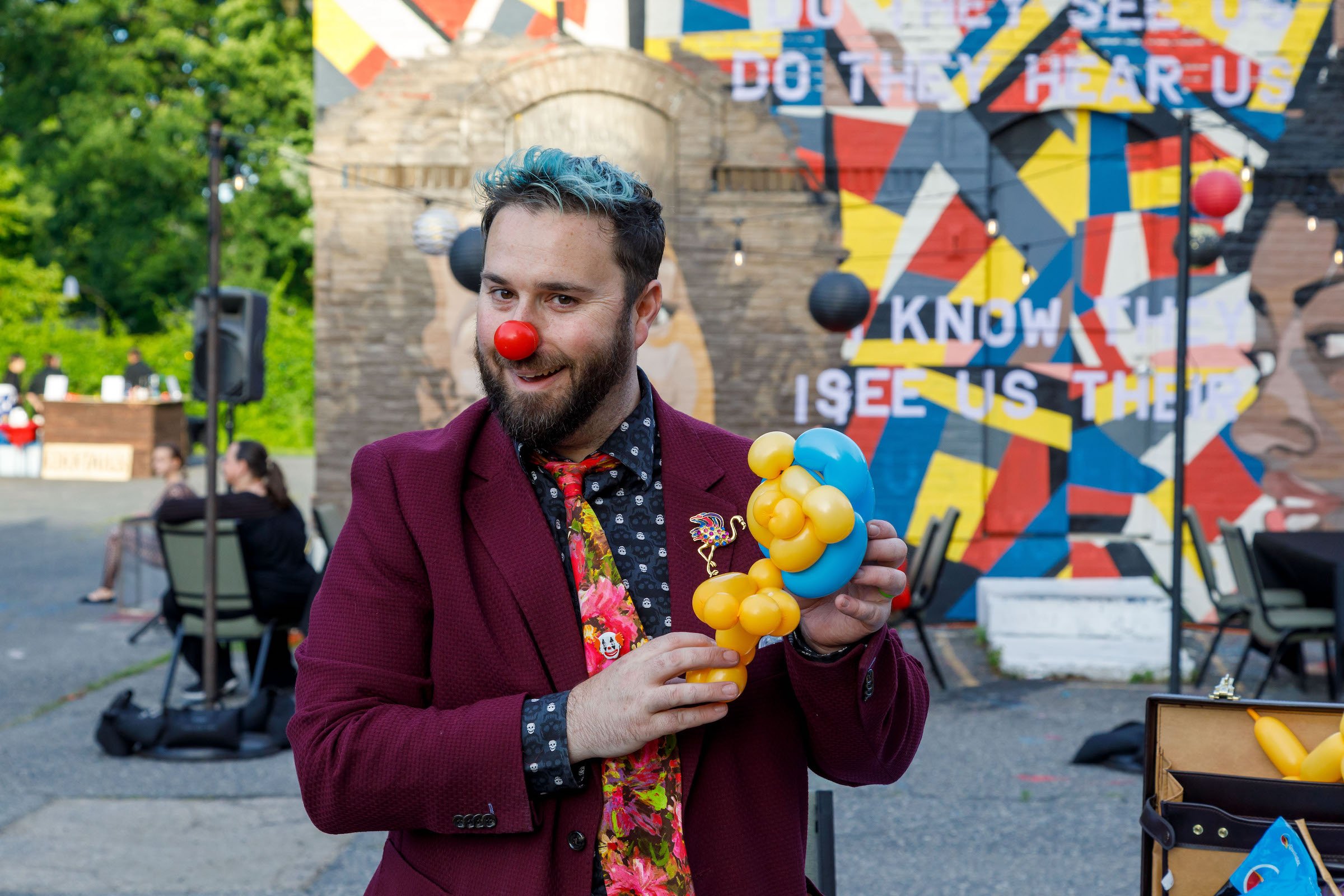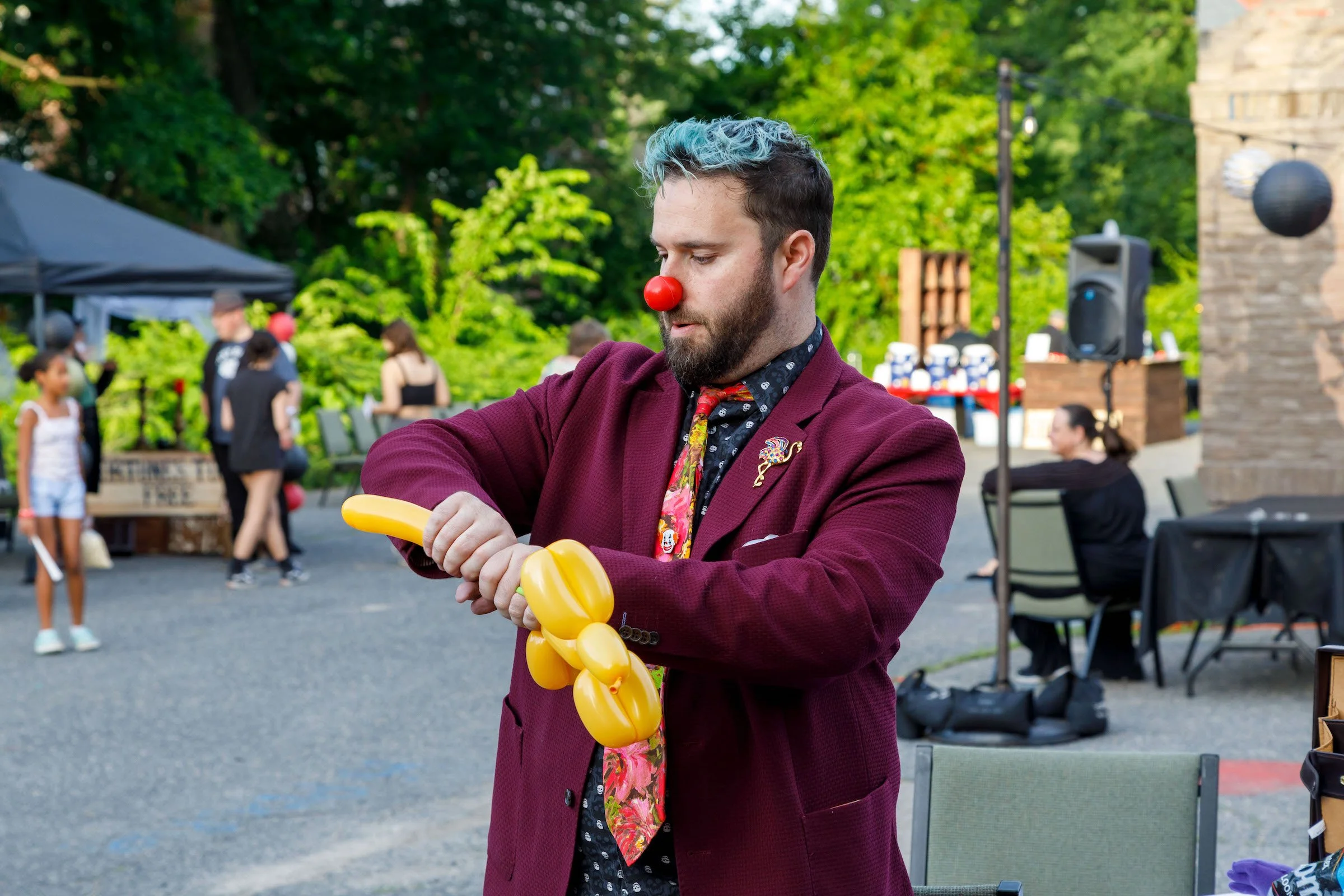Getting Down with the Clown
Nathaniel Joslin is a local artist, member of the Framingham Cultural Council, and occasionally embodies Bakē Bean—a friendly clown who brings moments of joy to the mental health profession. Well versed in the artform’s history, Joslin talked to us about the relationship between joy and happiness, evolving traditions, and clowns who fight Nazis.
atac: Okay let’s get into it. You are Bakē Bean II. Is there a Bakē Bean who sued you for copyright infringement?
NJ: Not yet! I guess it’ll depend on what I do with it. The original Bakē Bean was my mother. She was a birthday clown when I was born, so I guess you could say it's in my blood. The name, the face, and character are all passed on to me from her. When I make changes, she makes sure to correct me. Back in the day the faces were registered [*sometimes, with eggs] and I would not be able to take her face, but they dropped that so I don’t think she has grounds to sue.
atac: Clowning encompasses such a wide visual vocabulary—from the sort of “Big Top” look to Emmett Kelly’s Weary Willie (1921); from the suit-and-tie vibes of Laurel and Hardy to David Bowie's Blue Clown (1980)—what are your favorite clown styles?
NJ: I was very focused on the classics (Auguste, White Face, Tramp/character). My mother was an Auguste—and I think I have gone a bit off that direction, though we are not formally trained so who knows. I sort of do my own thing in all areas of my life. I always find myself drawn in the opposite direction, you mentioned Laurel and Hardy. I was a big fan growing up and very much found myself drawn in both directions—to the talking, “take-charge” character such a Hady, and the more silent type like Laurel. I more found myself drawn to The Marx Brothers. Harpo was just such a genius, and when he and Groucho got together for a scene it was gold. The play off of two clowns is the easiest way to make laughter. I find it more challenging when I am alone.
atac: You're also a licensed mental health counselor—which calls back to the origins of clowning—a sort of balance between humor and spirituality. How do you think about the two roles; what’s the relationship?
NJ: Laughter is the best medicine. Bringing clowning into my practice started with my theories on Joy vs Happiness. Happiness is a state of being, what we are all striving to be. It might be better described as contentedness, stability, and calming stress. But joy is an emotion, it is something happening in the moment. Clowning is a way to bring joy. I once made balloon animals at the program I work at and one girl got a little balloon cat—she brought it to her therapist's office and told her that her face hurt from smiling. In that moment I did not cure her trauma, her depression, or the stress she was experiencing in life, but in that moment of joy she didn’t experience the other stuff. While the therapist was able to turn that into a really good conversation, there is something to say about a moment of relief.
atac: On the other hand, coulrophobia (the fear of clowns) is real—and I’m talkin’ about the classic circus clown, not Pennywise. Have you ever unintentionally scared someone? What’s the best thing a clown can do when the audience reaction is the opposite of your intention?
NJ: I have never intentionally scared anyone. Many traditional clowns (birthday or event clowns) don’t even wear makeup or wear very minimal makeup because of this. It’s the reason my mom chose Auguste. One of her alley mates was a white faced and kids were often scared of her. If the audience is afraid of you as a clown, or has a reaction opposite to your intention, you can always lean in. Be afraid of them, scold them for not getting it, scold yourself for scaring the audience. You can play with kids in a non-threatening way.
I am part of a program called Red Nose Readers which reads to kids in libraries and school settings. Along with promoting literacy we help kids avoid developing a fear of clowns. Part of the Red Nose Readers approach is to put on our makeup slowly as part of the activity, to show kids the process. My mother did that with me when I was a baby.
atac: That reminds me of when Margaret Hamilton went on Mister Rogers; a really great moment. Switching gears—what’s the hardest balloon animal to make?
NJ: Teddy Bears. If you make the muzzle or arms too big, it becomes a Grizzly and you need a permit for that! The more twists, the harder it is. Each twist pushes the air further and further to the end of the balloon and if you run out, POP!
atac: The Hobo, the Tramp, and the Bum. These roles all seem to share a lack of work-ethic or self-created lack of opportunity. Like insults written by Western capitalism.
NJ: The Tramp/Hobo are a traditionally American Clown category, you are right on that. They come out of the Character Clown, which was typically focused on jobs. A doctor clown, a repairman clown, etc. They were modeled after people riding the trains looking for work after the great depression.
atac: They are down on their luck, but it’s not a situation they caused—is it punching-down?
NJ: Interestingly, in circuses and parades, they are often the only ones with an actual job—they do the clean up work. In recent times, younger clowns have adapted this into a sort of Bohemian lifestyle. I do think there is potential for these clowns to be seen as offensive, so you have to be careful with it.
atac: Thinking about offensiveness…Blackface, at least on Wikipedia, is listed as a subcategory of clowning. Does it show up in your circles?
NJ: Blackface is not clowning. Yes, it involves full face makeup and uses the idea of exaggerated features, but it does not fulfill the real spirit of clowning. Of course, there are no clowning laws. Someone can take their personal clowning in any direction, scary clown, burlesque clowns, and Juggalos are all departures from the traditional clown profile. That said, if an individual were to do a black-faced character it would be in very poor taste, and I would hope the clowning community would reject it.
atac: I'm glad you mentioned Juggalos. I think the FBI once labeled them a gang? But they always just felt like interesting / honest punk subculture to me. How has the professional clowning community responded to or embraced them?
NJ: My experience is that working clowns who follow the more traditional forms don’t acknowledge the other forms of clowning, like Juggalos or burlesque. The only group I’ve ever heard them speak out against is scary clowns because of the fear that already exists. But I think with a dying art, we have to embrace all forms. Drag Queens are also welcome to the club. All the makeup, exaggerated features, and playing with the audience—they are like sophisticated clowns, and I love what they do. Room for all!
atac: Can you talk a bit about the study, practice, and education around clowning?
NJ: There are lots of schools and conventions. The most popular around here is the North Eastern Clown Institute. But many people just learn from fellow clowns. There are lots of great alleys associated with the major clown organizations. I’m currently trying to start a Framingham Alley (note: an Alley is a chapter of a larger group such as Clowns of America International). Perhaps atac would like to be a part of that.
atac: You note that "Clowning is a way to bring joy," but it's also a way to be critical, skewering, etc. Do you have any favorite examples of clowning being used as a weapon against injustice?
NJ: There are lots of examples of clowning and humor being used against neo-Nazis rallies. I’ll share this article that highlights some great examples. I especially like the Knoxville, TN rally in 2005 where the clowns kept misunderstanding the “white power” cry by shouting back things like “white flour?” while throwing flour, “tight shower?” while holding up shower heads, “wife power,” etc.
atac: That is gold. So what should people expect from your persona at A Night at the Circus? What's the vibe you're bringing?
NJ: I’m meeting with my fellow performers this week to finalize how we are going to approach the night. I have been working out my personas over the past year. One is more of a yokel farmer and the other is more sophisticated. I believe I’ll be more sophisticated for A Night at the Circus.
atac: We have to ask: Your thoughts on the Big Red Boot?
NJ: Well, I do look good in red.
*
Grab tickets to A Night at the Circus here. The party goes down on Friday night June 16 from 6–9:30 PM.
Photos of Nathaniel Joslin by Lynn Damianos Photography. Please note our web-font does not correctly display the “ē” character, which is why Bakē Bean looks wierd. Sorry about that.Tags:


